Scottish Surveys Core Questions 2014
Official statistics publication on equality groups across a range of measures from harmonised questions across the major SG population surveys.
This document is part of a collection
1 Topics in this report
A number of variables in the SSCQ relate closely to key monitoring information for local and national government performance.
In this chapter the background for each of these indicators is provided along with the key statistics from the established source for each indicator. The indicator as formulated for discussion in the SSCQ report is then described alongside national estimates from the Core.
Note that SSCQ estimates differ in most cases and by varying degrees from the accepted national performance indicator or longer-running time series sources. SSCQ is designed to provide a suitable dataset for comparison between subgroups of the core questions, particularly where the individual surveys cannot produce such estimates due to insufficient sample sizes or other methdoological reasons. SSCQ national point estimates do not replace the accepted statistics from established sources.
SSCQ indicators are generally formulated as two-state variables for analysis. The indicator property is provided in a blue box followed by a description of the counter-indicator. These are designed wherever possible to match the description of current National Indicator statistics.
1.1 Self-assessed General Health
Self-assessed general health is a critical measure of the population's overall health status and a key marker of health inequalities. One of the Scottish Government's National Outcomes is the overall strategic objective for health: We live longer, healthier lives [5] . This is supported by a number of National Indicators including 'improve self-assessed general health' [6] .
1.1.1 National Estimates and Key Sources
The preferred source of statistics for time series at Scotland level is the Scottish Health Survey. Since the baseline year (2008) there has been little change in the proportion of adults who assess their health as good or very good. The level has fluctuated between 74% and 77% over this period, though in the last three years has been stable at 74% [7] .
Table 1: Good/very good general health, SHeS
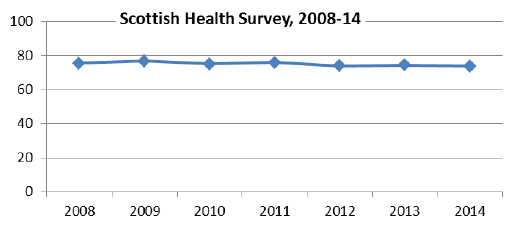
| Good/Very good general health (% adults) |
|
|---|---|
| 2008 | 75 |
| 2009 | 77 |
| 2010 | 75 |
| 2011 | 76 |
| 2012 | 74 |
| 2013 | 74 |
| 2014 | 74 |
1.1.2 SSCQ indicator
 the proportion of adults reporting good or very good general health
the proportion of adults reporting good or very good general health
The counter-indicator is the proportion of adults reporting fair, bad or very bad health or declining to answer. This differs form the SHeS indicator, which excludes those declining to answer.
This SSCQ analysis is the preferred source for comparison across demographic or area results. A comparison of SSCQ and census findings is provided in Annex A, and a comparison with constituent surveys in Annex B. The SSCQ shows around three quarters of adults reporting good or very good general health between 2012 and 2014.
Across all response categories in the general health question, responses are stable through the time series; changes between years generally do not exceed combined confidence intervals.
Table 2: General health series, 2012-2014
| 2012 |
2013 |
2014 |
||||
|---|---|---|---|---|---|---|
| Good/Very good |
73.8 |
± 0.7 |
75.2 |
± 0.8 |
74.1 |
± 0.7 |
| Fair |
19.0 |
± 0.6 |
17.4 |
± 0.6 |
18.6 |
± 0.6 |
| Bad/Very bad |
7.2 |
± 0.4 |
7.3 |
± 0.4 |
7.1 |
± 0.4 |
| Detailed Categories |
||||||
| Very good |
36.1 |
± 0.9 |
36.7 |
± 0.9 |
35.2 |
± 0.9 |
| Good |
37.6 |
± 0.8 |
38.5 |
± 0.9 |
38.9 |
± 0.8 |
| Fair |
19.0 |
± 0.6 |
17.4 |
± 0.6 |
18.6 |
± 0.6 |
| Bad |
5.6 |
± 0.4 |
5.7 |
± 0.4 |
5.5 |
± 0.4 |
| Very bad |
1.6 |
± 0.2 |
1.7 |
± 0.2 |
1.6 |
± 0.2 |
| Weighted and Unweighted Bases |
||||||
| Adults |
4,341,500 |
4,398,900 |
4,436,300 |
|||
| Sample |
20,527 |
21,038 |
20,153 |
|||
Under formal testing, the differences in the indicator between years are not statistically significant.
Levels of good or very good general health observed in the SSCQ agree with those in the SHeS across all three years of SSCQ data. Confidence intervals on SSCQ estimate contain the point estimates from SHeS in all cases.
1.2 Long-term Limiting Health Conditions
In the Scottish Government's National Action Plan on long-term conditions, long-term conditions are defined as 'health conditions that last a year or longer, impact on a person's life, and may require on-going care and support'. Conditions include a wide range of mental and physical health conditions.
Long-term conditions account for 80% of all GP consultations and for 60% of all deaths in Scotland [8] . The link with deprivation, lifestyle factors and wider health determinants is also of importance in Scotland, given its persistent health inequalities. Long-term conditions therefore represent personal, social and economic costs both to individuals and their families and to Scottish society more widely. Details of long-term conditions are discussed in full in Chapter 8 of the Scottish Health Survey [9] .
1.2.1 National Estimates and Key Sources
The preferred source of statistics for time series at Scotland level is the Scottish Health Survey [10] . Timeseries data is available back to 1998 and is provided in Table 3. In 2008 the wording of the question about long-term conditions was changed in line with moves to harmonise questions across all Scottish Government surveys and to bring it into line with the definition of disability used in the Disability Discrimination Act 2005.
The wording used in SHeS prior to this was: "Do you have any long-standing illness, disability or infirmity? By long-standing I mean anything that has troubled you over a period of time, or that is likely to affect you over a period of time?".
The question used from 2008 onwards is worded as follows: "Do you have any long-standing physical or mental condition or disability that has troubled you for at least 12 months, or that is likely to affect you for at least 12 months?".
The question changed again in 2012 to the current wording: "Do you have a physical or mental health condition or illness lasting, or expected to last, 12 months or more?"
For this reason trends in the prevalence of long-term illness or conditions must be interpreted with caution. However the longer term increase in the prevalence of long-term limiting health conditions is likely linked to the aging population of Scotland.
Table 3: Long-term limiting health condition, SHeS
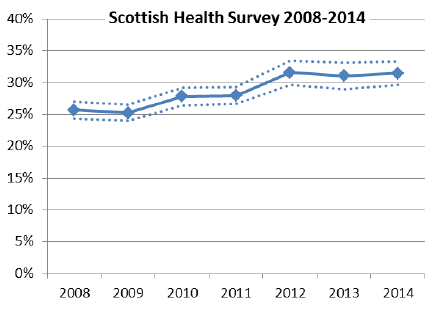
| Long-term limiting health condition (% adults) |
||
|---|---|---|
| 1998 |
24 |
± 1 |
| … |
||
| 2003 |
27 |
± 1 |
| … |
||
| 2008 |
26 |
± 1 |
| 2009 |
25 |
± 1 |
| 2010 |
28 |
± 1 |
| 2011 |
28 |
± 1 |
| 2012 |
32 |
± 2 |
| 2013 |
31 |
± 2 |
| 2014 |
31 |
± 2 |
Note that, contrary to the SSCQ reporting, these figures exclude those respondents who decline to answer.
1.2.2 SSCQ indicator
 the proportion of adults reporting a long-term mental or physical health condition that limits their day-to-day activities
the proportion of adults reporting a long-term mental or physical health condition that limits their day-to-day activities
The counter-indicator is the proportion of adults reporting no long-term limiting health condition or declining to respond. This differs form the SHeS indicator, which excludes those declining to answer.
Table 4: Long-term limiting health conditions series, 2012-2014
| 2012 |
2013 |
2014 |
||||
|---|---|---|---|---|---|---|
| Limiting Condition |
23.9 |
± 0.7 |
22.2 |
± 0.7 |
23.2 |
± 0.7 |
| No Limiting Condition |
75.9 |
± 0.7 |
77.4 |
± 0.7 |
76.3 |
± 0.7 |
| Weighted and Unweighted Bases |
||||||
| Adults |
4,341,500 |
4,398,900 |
4,436,300 |
|||
| Sample |
20,527 |
21,038 |
20,153 |
|||
Across the three years of SSCQ there is no detectable change in the prevalence of long-term limiting health conditions, in line with results from SHeS in Table 3. However estimates from the SSCQ are systematically lower than SHeS estimates.
Formulation of this indicator in SSCQ is slightly different due to exclusion of missing cases in the SHeS result. However this accounts for only a fraction of a percentage point difference in the SSCQ estimate. The underlying difference is more fundamental, and likely relates to context effects in the SHeS collection. Respondents are more likely to identify long-term conditions when asked about them in the context of a specific interview about numerous aspects of their health and wellbeing.
1.3 Smoking
Reducing smoking is a major priority for improving health. In Scotland, tobacco use is associated with over 10,000 deaths (around a quarter of all deaths) and around 128,000 hospital admissions every year. [11]
The Scottish Government's Tobacco Control Strategy sets a target to reduce smoking prevalence to 5% or lower by 2034. The actions taken by the Scottish Government to tackle the harm caused by tobacco include legislation to prohibit smoking in public places, which came into effect in March 2006, raising the age of sale for tobacco from 16 to 18 in 2007, implementation of a tobacco retail register in 2011, a ban on self-service sales from vending machines in 2013, and the introduction of a tobacco display ban in shops from 2013.
Two of the Scottish Government's National Performance Framework ( NPF) National Indicators are relevant to smoking. [12] There is a specific indicator on reducing the proportion of adults who are current smokers, as well as a more general indicator on reducing premature mortality (deaths from all causes in those aged under 75), for which smoking is a significant contributory factor. Details of smoking behaviour are discussed in full in Chapter 4 of the Scottish Health Survey [13] .
1.3.1 National Estimates and Key Sources
The preferred source of statistics on smoking for time series at Scotland level is the Scottish Household Survey. Smoking prevalence has reduced from 25% of adults in the baseline year, 2006, to 20% in 2014. In this context, the fall between 2013 and 2014 from 23% to 20% is relatively large.
Table 5: Current smokers, SHS
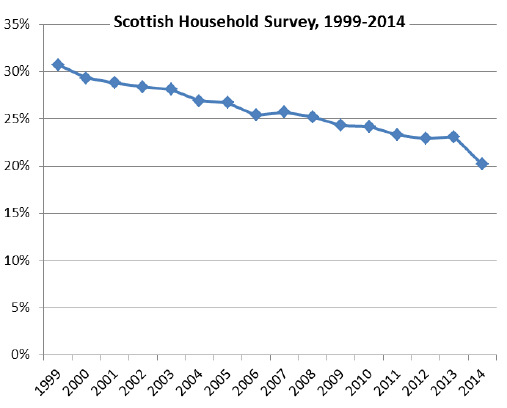
| Current Smokers |
|
|---|---|
| 1999 |
31% |
| 2000 |
29% |
| 2001 |
29% |
| 2002 |
28% |
| 2003 |
28% |
| 2004 |
27% |
| 2005 |
27% |
| 2006 |
25% |
| 2007 |
26% |
| 2008 |
25% |
| 2009 |
24% |
| 2010 |
24% |
| 2011 |
23% |
| 2012 |
23% |
| 2013 |
23% |
| 2014 |
20% |
1.3.2 SSCQ indicator
 the proportion of adults who report that they currently smoke cigarettes
the proportion of adults who report that they currently smoke cigarettes
The counter-indicator is the proportion of adults that report not smoking cigarettes or declining to respond.
Table 6: Smoking prevalence, 2012-2014
| 2012 |
2013 |
2014 |
||||
|---|---|---|---|---|---|---|
| Currently smokes cigarettes |
23.8 |
± 0.8 |
22.3 |
± 0.7 |
21.2 |
± 0.7 |
| Non-smoker |
76.1 |
± 0.8 |
77.5 |
± 0.7 |
78.6 |
± 0.7 |
| Weighted and Unweighted Bases |
||||||
| Adults |
4,341,500 |
4,398,900 |
4,436,300 |
|||
| Sample |
20,527 |
21,038 |
20,153 |
|||
According to the SSCQ, over three years the smoking rate has fallen from 23.8% in 2012 to 21.2% in 2014. This is consistent with the longer term trend identified by the Scottish Household Survey, which has recorded a ten percentage point fall from 1999 to 20.2% in 2014. [14]
The confidence intervals on SHS and SSCQ estimates overlap throughout the timeseries, indicating that these estimates are not statistically different.
1.4 Mental Wellbeing
Wellbeing is measured in the Scottish Health Survey using the Warwick-Edinburgh Mental Wellbeing Scale ( WEMWBS) questionnaire [15] . It has 14 items designed to assess: positive affect (optimism, cheerfulness, relaxation) and satisfying interpersonal relationships and positive functioning (energy, clear thinking, self-acceptance, personal development, mastery and autonomy). [16] The scale uses positively worded statements with a five-item scale ranging from '1 - none of the time' to '5 - all of the time'. Total score is the sum of these responses across the 14 questions. The scale therefore runs from 14 for the lowest levels of mental wellbeing to 70 for the highest.
WEMWBS is used to monitor the National Indicator 'improve mental wellbeing'. It is also part of the Scottish Government's adult mental health indicator set, and the mean score for parents of children aged 15 years and under on WEMWBS is included in the mental health indicator set for children. [17]
1.4.1 National Estimates and Key Sources
The mean score fell from 51.0 in 2006 to 50.0 in 2008, and has remained at a similar level since (ranging between 49.7 and 50.0).
| SHeS WEMWBS Scores | |
|---|---|
| Average WEMWBS Score | |
| 2008 | 50.0 |
| 2009 | 49.7 |
| 2010 | 49.9 |
| 2011 | 49.9 |
| 2012 | 49.9 |
| 2013 | 50.0 |
| 2014 | 50.0 |
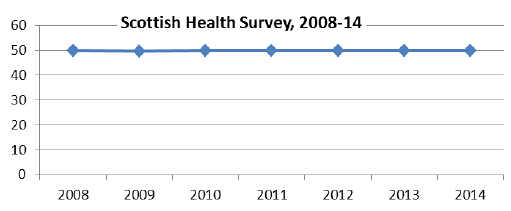
1.4.2 SSCQ indicator
 Average SWEMWBS score
Average SWEMWBS score
SWEMWBS is a shortened version of WEMWBS which is Rasch compatible. This means the seven items included have undergone a more rigorous test for internal consistency than the 14 item scale and have superior scaling properties. The seven items relate more to functioning than to feeling and therefore offer a slightly different perspective on mental wellbeing [18] . However, the correlation between WEMWBS and SWEMWBS is high at 95.4% [19] . The SWEMWBS scale runs from 7 for the lowest levels of mental wellbeing to 35 for the highest.
SWEMWBS statements are as follows:
- I've been feeling optimistic about the future
- I've been feeling useful
- I've been feeling relaxed
- I've been dealing with problems well
- I've been thinking clearly
- I've been feeling close to other people
- I've been able to make up my own mind about things
Scoring on the SWEMWBS scale is not a straightforward sum of response scores, but underoes a metric conversion, the effets of which are described in section 11.8.
The average SWEMWBS score after conversion was 24.5.
Prior to 2014, the SWEMWBS questions were not harmonised. Respondents who decline to answer one or more of the seven SWEMWEBS questions are excluded from statistics.
1.5 Provision of Unpaid Care
The provision of unpaid care is a key indicator of care needs and has important implications for the planning and delivery of health and social care services.
Caring can have a detrimental effect on the health and wellbeing of a carer and this can subsequently impact on the person that is being cared for. [20] Local authorities have a duty to assess a carer's ability to care and the power to provide support where necessary. NHS boards can also be required to publish a carer information strategy setting out how carers will be informed of their right to request an assessment.
The Carers (Scotland) Bill was passed by the Scottish Parliament on 4 February 2016 and sets out a range of measures intended to improve the support given to carers [21] . This includes the introduction of new duties on local authorities to support carers who are assessed as needing support and who meet eligibility criteria.
1.5.1 National Estimates and Key Sources
The Scottish Health Survey estimates that 16% of adults provided unpaid care in 2014.
Table 7: Provision of unpaid care, SHeS
|
|
2012 |
2013 |
2014* |
|
|---|---|---|---|---|
| Provides Care |
Yes |
18% |
16% |
16% |
| No |
82% |
84% |
84% |
|
| Sample |
4,815 |
4,893 |
3,459 |
|
In 2014 the question wording was altered in the second quarter of the collection period. As a result only three quarters of the respondent group were asked the question in it's current form. For further details see section 11.8.
The care question in the SHS was also altered in Q2 2014. Previously it was asked of the highest income householder about all members of the household. In Q2 2014 it moved to the Random Adult module of the survey and so becomes comparable to the other surveys in the core. The point estimate for the valid three quarters of the SHS was that 17% of adults provide unpaid care, based on a sample of 7,730 respondents. This estimate does not differ from the SHeS result at national level.
1.5.2 SSCQ indicator
This is the first year where it has been possible to provide statistics from SSCQ on provision of care. The question was fully harmonised across the three surveys in quarter 2 of 2014. Respondents in quarter 1 were not harmonised and have therefore been excluded.
For that reason the sample size for this indicator is somewhat smaller at 16,518 cases (compared to the sample of 20,153 for most individual-level questions). To counteract any additional bias as a result of this loss of sample, a specific weight for this question has been calculated and is used for all analysis of unpaid care provision. For further information see section 11.8.
 The proportion of adults who provide help or support to family members, friends, neighbours or others because of long-term physical or mental health issues, disability or old age
The proportion of adults who provide help or support to family members, friends, neighbours or others because of long-term physical or mental health issues, disability or old age
The counter-indicator is the proportion of adults who do not provide such care. Due to the methodological changes, non-responding individuals are excluded.
Table 8: Provision of unpaid care, SSCQ 2014
| 2014 |
||
|---|---|---|
| Provides care |
17.9 |
± 0.7 |
| Not providing care |
82.1 |
± 0.7 |
| Weighted and Unweighted Bases |
||
| Adults |
4,436,300 |
|
| Sample |
16,867 |
|
The SSCQ estimates that 17.9% of adults in Scotland provided unpaid care in 2014.
Although the SSCQ estimate is somewhat higher, the confidence intervals on SHeS and SSCQ estimates overlap indicating that these results are not statistically different.
1.6 Perceptions of Change in Local Crime Rate
Respondents who had lived in their current neighbourhood for 2 or more years were asked how they perceive the crime rate in their area to have changed over the past year. The choices were 'a lot less', 'a little less', 'about the same', 'a little more', 'a lot more' crime, or 'don't know'. Responses were grouped into three groups for analysis:
- 'a lot less', 'a little less' or 'about the same'
- 'a little more' or 'a lot more'
- 'don't know' [22]
1.6.1 National Estimates and Key Sources
The preferred source of statistics on time series of the perception of crime is the Scottish Crime and Justice Survey ( SCJS). [23] The SCJS 2014-15 found around three-quarters of adults perceived the crime rate in their local area to have stayed the same or reduced in the past two years.
Table 9: Perceived change in crime rate in local area, SCJS
| Perceived change in crime rate in local area in last two years: |
Column % |
2008/9 to 2014/15 |
2012/13 to 2014/15 |
|||||
|---|---|---|---|---|---|---|---|---|
| 2008/9 |
2009/10 |
2010/11 |
2012/13 |
2014/15 |
||||
| About the same, or a little / lot less |
69 |
71 |
73 |
76 |
75 |
5.7 |
* |
-1.1 |
| A little / lot more |
28 |
25 |
23 |
20 |
20 |
-7.6 |
* |
0.5 |
Following an increase between 2006 (65%) and 2012/13 (76%), the proportion of adults who perceived the crime rate in their local area to have stayed the same or reduced in the past two years has not changed since 2012/13; the apparent one percentage point decrease to 75% in 2014/15 is not a statistically significant change.
Figure 2: Perceptions of how crime rates have changed locally in the past two years (Scottish Crime Surveys) [24]
![Figure 2: Perceptions of how crime rates have changed locally in the past two years (Scottish Crime Surveys)[24] Figure 2: Perceptions of how crime rates have changed locally in the past two years (Scottish Crime Surveys)[24]](/binaries/content/gallery/publications/statistics-publication/2016/05/scottish-surveys-core-questions-2014/00500681.gif)
1.6.2 SSCQ indicator
 Excluding those who have lived in the neighbourhood for less than 2 years, the proportion of adults reporting crime in their local area to be 'a lot less', 'a little less' or 'about the same'
Excluding those who have lived in the neighbourhood for less than 2 years, the proportion of adults reporting crime in their local area to be 'a lot less', 'a little less' or 'about the same'
The counter-indicator is the proportion of adults reporting crime in their area to be 'a little more', 'a lot more' or declining to respond (excluding those who have lived in the neighbourhood for less than 2 years). For this reason the sample base and population is lower than for other crime indicators.
A comparison of estimates from data pooled from the SCJS 2014-15 and estimates in SSCQ 2014 is provided in Annex B.
Table 10: Perception of Local Crime Rate series, SSCQ 2012-2014
| 2012 |
2013 |
2014 |
||||
|---|---|---|---|---|---|---|
| About the same/A little/A lot less |
75.8 |
± 0.8 |
77.6 |
± 0.8 |
77.4 |
± 0.9 |
| A little/A lot more |
19.3 |
± 0.8 |
16.0 |
± 0.7 |
16.2 |
± 0.8 |
| Detailed Categories |
||||||
| A lot less |
1.9 |
± 0.3 |
1.7 |
± 0.3 |
2.0 |
± 0.3 |
| A little less |
7.6 |
± 0.5 |
8.1 |
± 0.5 |
8.6 |
± 0.6 |
| About the same |
66.3 |
± 0.9 |
67.8 |
± 0.9 |
66.8 |
± 1.0 |
| A little more |
13.9 |
± 0.7 |
12.2 |
± 0.6 |
12.2 |
± 0.7 |
| A lot more |
5.4 |
± 0.4 |
3.9 |
± 0.4 |
3.9 |
± 0.4 |
| Weighted and Unweighted Bases |
||||||
| Adults |
3,667,000 |
3,870,500 |
3,891,800 |
|||
| Sample |
16,869 |
17,398 |
16,518 |
|||
77.4% of adults reported that crime in their area had decreased or stayed the same in 2014. This represents an increase from 2012 of 1.6 percentage points.
Compared with Table 9, estimates provided by SCJS are somewhat lower than the levels recorded by SSCQ. This may relate to context effects in the SCJS collection. It is thought that respondents may be more likely to answer more negatively in response to questions about local crime rates when asked about them in the context of an interview about crime, victimisation and policing.
1.7 Confidence in Police
Survey respondents, regardless of whether they had ever been in contact with the police, were asked how confident they were in the ability of the police in their local area to undertake specific aspects of police work.
A. prevent crime
B. respond quickly to appropriate calls and information from the public
C. deal with incidents as they occur
D. investigate incidents after they occur
E. solve crimes
F. catch criminals
Response options were 'very', 'fairly', 'not very', or 'not at all' confident.
The preferred source for these statistics is the Scottish Crime and Justice Survey ( SCJS), which provides a time series back to 2008-09. The results of the SCJS are which are used for National Indicators [25] and Justice Outcome Indicators [26] .
1.7.1 National Estimates and Key Sources
The preferred source of statistics on time series of the perception of crime is the Scottish Crime and Justice Survey ( SCJS). [27]
As shown in Table 11, since 2008/09 there have been statistically significant increases in public confidence across each of the six measures. Between 2012/13 and 2014/15, there were small but statistically significant decreases in four of the police confidence measures (the proportion of adults confident in their local police forces ability to investigate incidents, deal with incidents, respond quickly and solve crimes). The changes in the results for the other two measures (the proportion of adults confident in their local police forces ability to catch criminals and prevent crime) were not statistically significant.
Table 11: Police confidence responses, SCJS 2008/9-2014/15 [28]
| Confidence in local police force's ability to: |
Very/Fairly Confident (%) |
2008/9 to 2014/15 |
2012/13 to 2014/15 |
|||||||
|---|---|---|---|---|---|---|---|---|---|---|
| 2008/9 |
2009/10 |
2010/11 |
2012/13 |
2014/15 |
||||||
| A |
Prevent Crime |
46 |
48 |
50 |
56 |
57 |
10.9 |
* |
0.8 |
|
| B |
Respond to calls |
54 |
58 |
61 |
66 |
64 |
9.4 |
* |
-2.2 |
* |
| C |
Deal with incidents |
58 |
61 |
65 |
68 |
66 |
7.8 |
* |
-2.6 |
* |
| D |
Investigate incidents |
64 |
68 |
71 |
73 |
70 |
6.5 |
* |
-2.4 |
* |
| E |
Solve crimes |
57 |
60 |
64 |
64 |
62 |
5.0 |
* |
-1.7 |
* |
| F |
Catch criminals |
55 |
57 |
60 |
61 |
60 |
4.7 |
* |
-1.1 |
|
| SCJS Respondents |
16,000 |
16,040 |
13,010 |
12,050 |
11,470 |
|||||
1.7.2 SSCQ indicator
 the proportion of adults reporting that they are 'very confident' or 'fairly confident' in the ability of Police to perform a given function
the proportion of adults reporting that they are 'very confident' or 'fairly confident' in the ability of Police to perform a given function
The counter-indicator is the proportion of adults reporting that they are 'not very' or 'not at all' confident or declining to respond.
The proportion of positive responses to the individual questions are provided in Table 12. Detailed breakdowns of these questions by all four response options (very/fairly/not very/not at all confident) are included in supplementary tables [29] .
Table 12: Police confidence questions series, SSCQ 2012-2014
| Very/fairly confident in Police to... |
2012 |
2013 |
2014 |
||||
|---|---|---|---|---|---|---|---|
| A |
prevent crime |
57.2 |
± 0.9 |
57.4 |
± 0.9 |
58.2 |
± 1.0 |
| B |
respond quickly to appropriate calls and information from the public |
65.6 |
± 0.9 |
66.5 |
± 0.9 |
66.3 |
± 0.9 |
| C |
deal with incidents as they occur |
68.3 |
± 0.8 |
68.2 |
± 0.9 |
68.0 |
± 0.9 |
| D |
investigate incidents after they occur |
70.2 |
± 0.8 |
69.3 |
± 0.9 |
70.3 |
± 0.9 |
| E |
solve crimes |
62.1 |
± 0.9 |
62.6 |
± 0.9 |
63.2 |
± 0.9 |
| F |
catch criminals |
60.1 |
± 0.9 |
60.5 |
± 0.9 |
61.6 |
± 0.9 |
| Weighted and Unweighted Bases |
|||||||
| Adults |
4,341,500 |
4,398,900 |
4,436,300 |
||||
| Sample |
19,516 |
19,395 |
18,499 |
||||
The proportion of positive responses across all six questions has not changed significantly over the three years of SSCQ.
Confidence intervals on estimates from SSCQ across all six police confidence questions overlap with estimates produced by SCJS; the results are not statistically different. Any differences that do arise in the point estimates provided by the two sources may relate to context effects in the SCJS collection, where respondents may answer differently in response to questions about confidence in policing when asked about them in the context of an interview about crime and victimisation.
A novel analytical technique has been employed to analyse patterns of response across these questions in the SSCQ. These results are released as "Statistics in Development" in an accompanying paper [30] . An overview of underlying classes revealed by this analysis is provided in Figure 3, but subgroup analyses are not discussed in this report except to reference the supplementary paper. Comments on these results are welcome and should be directed to the SSCQ Project Team: sscq@gov.scot.
Figure 3: Police confidence classes, SSCQ 2014 [31]
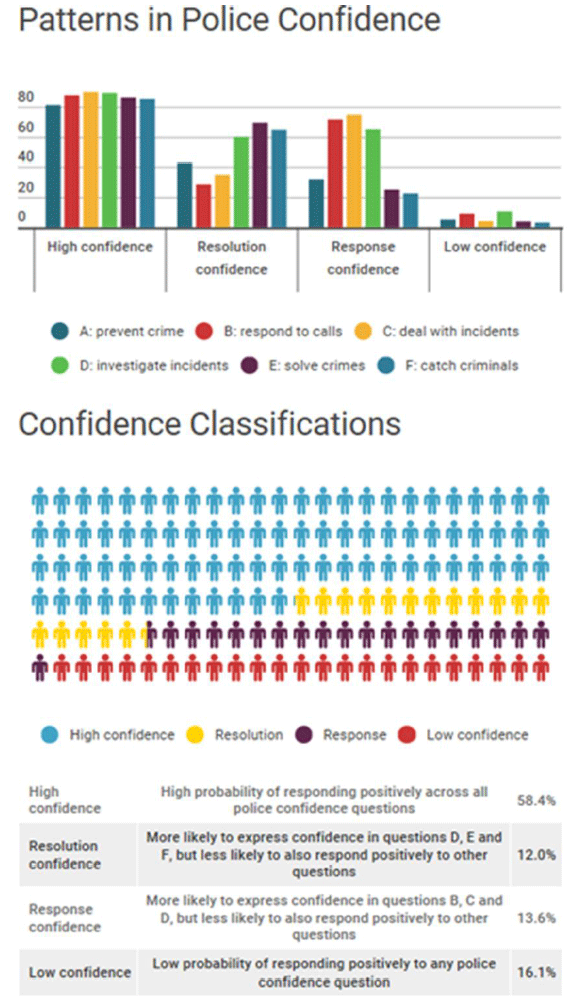
Contact
There is a problem
Thanks for your feedback